Re-Os Isotope Systematics of Sulfides in Chromitites and Host Lherzolites of the Andaman Ophiolite, India
Abstract
1. Introduction
2. Geological Background
3. Materials and Methods
3.1. Samples
3.2. Chromite
3.3. Platinum-Group Minerals and Base-Metal Sulfides
4. Results
4.1. Geochemistry of Chromite in Chromitite
4.2. Elememtal and Isotopic Composition of Platinum-Group Minerals in Chromitite
4.3. Isotopic Compositions of Base-Metal Sulfides in Peridotites
5. Discussion
5.1. Genesis of the Andaman Chromitites in the Upper Mantle
5.2. Significance of Re-Os Data in Platinum Group Minerals and Base-Metal Sulfides
5.3. Interpretation of Os Model Ages
Supplementary Materials
Author Contributions
Funding
Acknowledgments
Conflicts of Interest
References
- Leblanc, M.; Nicolas, A. Ophiolitic chromitites. Int. Geol. Rev. 1992, 34, 653–686. [Google Scholar] [CrossRef]
- González-Jiménez, J.M.; Griffin, W.L.; Proenza, J.A.; Gervilla, F.; O’Reilly, S.Y.; Akbulut, M.; Pearson, N.J.; Arai, S. Chromitites in ophiolites: How, where, when, why? Part II. The crystallisation of chromitites. Lithos 2014, 189, 140–158. [Google Scholar] [CrossRef]
- Arai, S.; Miura, M. Formation and modification of chromitites in the mantle. Lithos 2016, 264, 277–295. [Google Scholar] [CrossRef]
- Arai, S.; Abe, N. Reaction of orthopyroxene in peridotite xenoliths with alkali basalt melt and its implications for genesis of alpine-type chromitite. Am. Mineral. 1995, 80, 1041–1047. [Google Scholar] [CrossRef]
- Zhou, M.F.; Robinson, P.T.; Bai, W.J. Formation of podiform chromites by melt–rock interaction in the upper mantle. Mineral. Depos. 1994, 29, 98–101. [Google Scholar] [CrossRef]
- Melcher, F.; Grum, W.; Simon, G.; Thalhammer, T.V.; Stumpfl, E.F. Petrogenesis of the ophiolitic giant chromite deposits of Kempirsai, Kazakhstan: A study of solid and fluid inclusions in chromite. J. Petrol. 1997, 38, 1419–1458. [Google Scholar] [CrossRef]
- Proenza, J.A.; Gervilla, F.; Melgarejo, J.C.; Bodinier, J.L. Al- and Cr-rich chromitites from the Mayarí–Baracoa Ophiolitic Belt (Eastern Cuba): Consequence of interaction between volatile-rich melts and peridotites in suprasubduction mantle. Econ. Geol. 1999, 94, 547–566. [Google Scholar] [CrossRef]
- Gervilla, F.; Proenza, J.A.; Frei, R.; González-Jiménez, J.M.; Garrido, C.J.; Melgarejo, J.C.; Meibom, A.; Díaz-Martínez, R.; Lavaut, W. Distribution of platinum-group elements and Os isotopes in chromite ores from Mayarí–Baracoa Ophiolilte Belt (eastern Cuba). Contrib. Mineral. Petrol. 2005, 150, 589–607. [Google Scholar] [CrossRef]
- González-Jiménez, J.M.; Griffin, W.L.; Gervilla, F.; Proenza, J.A.; O’Reilly, S.Y.; Pearson, N.J. Chromitites in ophiolites: How, where, when, why? Part I. Origin and significance of platinum-group minerals. Lithos 2014, 189, 127–139. [Google Scholar]
- Yamamoto, S.; Komiya, T.; Yamamoto, H.; Kaneko, Y.; Terabayashi, M.; Katayama, I.; Iizuka, T.; Maruyama, S.; Yang, J.; Kon, Y.; et al. Recycled crustal zircons from podiform chromitites in the Luobusa ophiolite, southern Tibet. Island Arc 2013, 22, 89–103. [Google Scholar] [CrossRef]
- Belousova, E.A.; González-Jiménez, J.M.; Graham, I.; Griffin, W.L.; O’Reilly, S.Y.; Pearson, N.; Martin, L.; Craven, S. The enigma of crustal zircons in upper mantle rocks: Clues from the Coolac ultramafic complex, SE Australia. Geology 2015, 43, 123–126. [Google Scholar] [CrossRef]
- González-Jiménez, J.M.; Camprubí, A.; Colás, V.; Griffin, W.L.; Proenza, J.A.; O’Reilly, S.Y.; Centeno-García, E.; García-Casco, A.; Belousova, E.; Talavera, C.; et al. The recycling of chromitites in ophiolites from southwestern North America. Lithos 2017, 294, 53–72. [Google Scholar] [CrossRef]
- Proenza, J.A.; González-Jiménez, J.M.; García-Casco, A.; Belousova, E.; Griffin, W.L.; Talavera, C.; Rojas-Agramonte, Y.; Aiglsperger, T.; Navarro-Ciurana, D.; Pujol-Solà, N.; et al. Cold plumes trigger contamination of oceanic mantle wedges with continental crust-derived sediments: Evidence from chromitite zircon grains of eastern Cuban Ophiolites. Geosci. Front. 2018, in press. [Google Scholar] [CrossRef]
- Zhou, M.F.; Robinson, P.T.; Su, B.X.; Gao, J.F.; Li, J.W.; Yang, J.S.; Malpas, J. Compositions of chromite, associated minerals, and parental magmas of podiform chromite deposits: The role of slab contamination of asthenospheric melts in suprasubduction zone environments. Gondwana Res. 2014, 26, 262–283. [Google Scholar] [CrossRef]
- Robinson, P.T.; Trumbull, R.B.; Schmitt, A.; Yang, J.S.; Li, J.W.; Zhou, M.F.; Erzinger, J.; Dare, S.; Xiong, F. The origin and significance of crustal minerals in ophiolitic chromitites and peridotites. Gondwana Res. 2015, 27, 486–506. [Google Scholar] [CrossRef]
- Griffin, W.L.; Afonso, J.C.; Belousova, E.A.; Gain, S.E.; Gong, X.H.; González-Jiménez, J.M.; Howell, D.; Huang, J.X.; McGowan, N.; Pearson, N.J.; et al. Mantle recycling: Transition zone metamorphism of Tibetan ophiolitic peridotites and its tectonic implications. J. Petrol. 2016, 57, 655–684. [Google Scholar] [CrossRef]
- Arai, S. Possible recycled origin for ultrahigh-pressure chromitites in ophiolites. J. Mineral. Petrol. Sci. 2010, 105, 280–285. [Google Scholar] [CrossRef]
- McGowan, N.M.; Griffin, W.L.; González-Jiménez, J.M.; Belousova, E.A.; Afonso, J.; Shi, R.; McCammon, C.A.; Pearson, N.J.; O’Reilly, S.Y. Tibetan chromitites: Excavating the slab graveyard. Geology 2015, 43, 179–182. [Google Scholar] [CrossRef]
- Yamamoto, S.; Komiya, T.; Hirose, K.; Maruyama, S. Coesite and clinpyorexene exsolution lamellae in chromite: In-situ ultrahigh-pressure evidence from podiform chromitites in the Luobusa ophiolite, southern Tibet. Earth Planet. Sci. Lett. 2009, 109, 314–322. [Google Scholar]
- Xiong, Q.; Griffin, W.L.; Huang, J.X.; Gain, S.E.; Toledo, V.; Pearson, N.J.; O’Reilly, S.Y. Super-reduced mineral assemblages in “ophiolitic” chromitites and peridotites: The view from Mount Carmel. Eur. J. Mineral. 2017, 29, 557–570. [Google Scholar] [CrossRef]
- Zhang, Y.; Jin, Z.; Griffin, W.L.; Wang, C.; Wu, Y. High-pressure experiments provide insights into the Mantle Transition Zone history of chromitite in Tibetan ophiolites. Earth Planet. Sci. Lett. 2017, 463, 151–158. [Google Scholar] [CrossRef]
- Satsukawa, T.; Griffin, W.L.; Piazolo, S.; O’Reilly, S.Y. Messengers from the deep: Fossil wadsleyite–chromite microstructures from the Mantle Transition Zone. Sci. Rep. 2015, 5, 16484. [Google Scholar] [CrossRef] [PubMed]
- Ruskov, T.; Spirov, I.; Georgieva, M.; Yamamoto, S.; Green, H.W.; McCammon, C.A.; Dobrzhinetskaya, L.F. Mossbauer spectroscopy studies of the valence state of iron in chromite from the Luobusa massif of Tibet: Implications for a highly reduced deep mantle. J. Metamorph. Geol. 2010, 28, 551–560. [Google Scholar] [CrossRef]
- Wu, Y.; Xu, M.; Jin, Z.; Fei, Y.; Robinson, P.T. Experimental constraints on the formation of the Tibetan podiform chromitites. Lithos 2016, 245, 109–117. [Google Scholar] [CrossRef]
- Xiong, F.; Yang, J.; Robinson, P.T.; Xu, X.; Ba, D.; Li, Y.; Zhang, Z.; Rong, H. Diamonds and other exotic minerals recovered from peridotites of the Dangqiong Ophiolite, western Yarlung–Zangbo suture zone, Tibet. Acta Geol. Sin. 2016, 90, 425–439. [Google Scholar]
- Xu, X.; Yang, J.; Robinson, P.T.; Xiong, F.; Ba, D.; Guo, G. Origin of ultrahigh pressure and highly reduced minerals in podiform chromitites and associated mantle peridotites of the Luobusa ophiolite, Tibet. Gondwana Res. 2015, 27, 686–700. [Google Scholar] [CrossRef]
- Yang, J.S.; Meng, F.; Xu, S.; Robinson, P.T.; Dilek, Y.; Makeyev, A.B.; Wirth, R.; Wiedenbeck, M.; Cliff, J. Diamonds, native elements and metal alloys from chromitite of the Ray-Iz ophiolite of the Polar Urals. Gondwana Res. 2015, 27, 459–485. [Google Scholar] [CrossRef]
- Farré de Pablo, J.; Proenza, J.; González-Jiménez, J.M.; Aiglsperger, T.; Garcia-Casco, A.; Escuder-Viruete, J.; Colás, V.; Longo, F. Ophiolite hosted chromitite formed by supra-subduction zone peridotite–plume interaction. Geosci. Front. 2020. [Google Scholar] [CrossRef]
- Pujol-Solà, N.; Proenza, J.A.; Garcia-Casco, A.; González-Jiménez, J.M.; Andreazini, A.; Melgarejo, J.C.; Gervilla, F. An alternative scenario on the origin of ultra-high pressure (UHP) and super-reduced (SUR) minerals in ophiolitic chromitites: A case study from the mercedita deposit (Eastern Cuba). Minerals 2018, 8, 433. [Google Scholar] [CrossRef]
- Farré de Pablo, J.; Proenza, J.; González-Jiménez, J.M.; Garcia-Casco, A.; Colás, V.; Roqué-Rosell, J.; Camprubí, A.; Sánchez-Navas, A. A shallow origin for diamonds in ophiolitic chromitites. Geology 2018, 47, 75–78. [Google Scholar] [CrossRef]
- Frei, R.; Gervilla, F.; Meibom, A.; Proenza, J.A.; Garrido, C.J. Os isotope heterogeneity of the upper mantle: Evidence from the Mayarí–Baracoa ophiolite belt in eastern Cuba. Earth Planet. Sci. Lett. 2006, 241, 466–476. [Google Scholar] [CrossRef]
- Shi, R.; Alard, O.; Zhi, X.; O’Reilly, S.Y.; Pearson, N.J.; Griffin, W.L.; Zhang, M.; Chen, X. Multiple events in the Neo-Tethyan oceanic upper mantle: Evidence from Ru–Os–Ir alloys in the Luobusa and Dongqiao ophiolitic podiform chromitites, Tibet. Earth Planet. Sci. Let. 2007, 261, 33–48. [Google Scholar] [CrossRef]
- Shi, R.; Griffin, W.L.; O’Reilly, S.; Huang, Q.; Zhang, X.; Liu, D.; Zhi, X.; Xia, Q.; Ding, L. Melt/mantle mixing produces podiform chromite deposits in ophiolites: Implications of Re–Os systematics in the Dongqiao Neo-tethyan ophiolite, northern Tibet. Gondwana Res. 2012, 21, 194–206. [Google Scholar] [CrossRef]
- Malitch, K.N.; Junk, S.A.; Thalhammer, O.A.R.; Melcher, F.; Knauf, V.V.; Pernicka, E.; Stumpfl, E.F. Laurite and ruarsite from podiform chromitites at Kraubath and Hochgrössen, Austria: New insights from osmium isotopes. Can. Mineral. 2003, 41, 331–352. [Google Scholar] [CrossRef]
- Malitch, K.N. Osmium isotope constraints on contrasting sources and prolonged melting in the Proterozoic upper mantle: Evidence from ophiolitic Ru–Os sulfides and Ru–Os–Ir alloys. Chem. Geol. 2004, 208, 157–173. [Google Scholar] [CrossRef]
- Ahmed, A.H.; Hanghøj, K.; Kelemen, P.B.; Hart, S.R.; Arai, S. Osmium isotope systematics of the Proterozoic and Phanerozoic ophiolitic chromitites: In situ ion probe analysis of primary Os-rich PGM. Earth Planet. Sci. Let. 2006, 245, 777–791. [Google Scholar] [CrossRef]
- Marchesi, C.; González-Jiménez, J.M.; Gervilla, F.; Garrido, C.J.; Griffin, W.L.; O’Reilly, S.Y.; Proenza, J.A.; Pearson, N.J. In situ Re–Os isotopic analysis of platinum-group minerals from the Mayarí–Cristal ophiolitic massif (Mayarí–Baracoa Ophiolitic Belt, eastern Cuba): Implications for the origin of Os-isotope heterogeneities in podiform chromitites. Contrib. Mineral. Petrol. 2011, 161, 977–990. [Google Scholar] [CrossRef]
- González-Jiménez, J.M.; Griffin, W.L.; Gervilla, F.; Kerestedjian, T.; O’Reilly, S.Y.; Proenza, J.; Pearson, B.J.; Sergeeva, I. Metamorphism disturbs the Re-Os signatures of platinum-group minerals in ophiolite chromitites. Geology 2012, 40, 659–662. [Google Scholar] [CrossRef]
- González-Jiménez, J.; Marchesi, C.; Griffin, W.L.; Gutiérrez-Narbona, R.; Lorand, J.-P.; O’Reilly, S.Y.; Garrido, C.J.; Gervilla, F.; Pearson, N.J.; Hidas, K. Transfer of Os isotopic signatures from peridotite to chromitite in the subcontinental mantle: Insights from in situ analysis of platinum-group and base-metal minerals (Ojén peridotite massif, southern Spain). Lithos 2013, 164–167, 74–85. [Google Scholar] [CrossRef]
- González-Jiménez, J.M.; Locmelis, M.; Belousova, E.; Griffin, W.L.; Gervilla, F.; Kerestedjian, T.; O’Reilly, S.Y.; Sergeeva, I.; Pearson, N.J. Genesis and tectonic implications of podiform chromitites in the metamorphosed Ultramafic Massif of Dobromirtsi (Bulgaria). Gond. Res. 2015, 27, 555–574. [Google Scholar] [CrossRef]
- Pearson, D.G.; Parman, S.W.; Nowell, G.M. A link between large mantle melting events and continent growth seen in osmium isotopes. Nature 2007, 449, 202–205. [Google Scholar] [CrossRef] [PubMed]
- Xiong, Q.; Xu, Y.; González-Jiménez, J.M.; Liu, J.; Alard, O.; Zheng, J.-P.; Griffin, W.L.; O’Reilly, S.Y. Sulfide in dunite channels reflects long-distance reactive migration of mid-ocean-ridge melts from mantle source to crust: A Re-Os isotopic perspective. Earth Planet. Sci. Lett. 2020, 531, 115969. [Google Scholar] [CrossRef]
- Ghosh, B.; Mukhopadhyay, S.; Morishita, T.; Tamura, A.; Arai, S.; Bandyopadhyay, D.; Chattopadhaya, S.; Ovung, T.N. Diversity and evolution of suboceanic mantle: Constraints from Neotethyan ophiolites at the eastern margin of the Indian plate. J. Asian Earth Sci. 2018, 160, 67–77. [Google Scholar] [CrossRef]
- Ghosh, B.; Bandyopadhyay, D.; Morishita, T. Andaman–Nicobar ophiolites, India: Origin, evolution and emplacement. Geol. Soc. Lond. Mem. 2017, 47, 95–110. [Google Scholar] [CrossRef]
- Bandyopadhyay, D.; Hinsbergen, D.; Plunder, A.; Bandopadhyay, P.; Advokaat, E.; Chattopadhaya, S.; Morishita, T.; Ghosh, B. Andaman Ophiolite: An Overview. In The Andaman Islands and Adjoining Offshore: Geology, Tectonics and Palaeoclimate; Springer: Berlin, Germany, 2020; pp. 1–17. [Google Scholar]
- Saha, A.; Santosh, M.; Ganguly, S.; Manikyamba, C.; Ray, J.; Dutta, J. Geochemical cycling during subduction initiation: Evidence from serpentinized mantle wedge peridotite in the south Andaman ophiolite suite. Geosci. Front. 2018, 1–21, in press. [Google Scholar] [CrossRef]
- Pal, T.; Chakraborty, P.P.; Duttagupta, T.; Singh, C.D. Geodynamic evolution of an outer arc in convergent margin of active Burma–Java subduction complex, a document from Andaman islands, Bay of Bengal. Geol. Mag. 2003, 140, 289–307. [Google Scholar] [CrossRef]
- Ghosh, B.; Pal, T.; Bhattacharya, A.; Das, D. Petrogenetic implications of ophiolitic chromite from Rutland Island, Andaman—A boninitic parentage in supra-subduction setting. Mineral. Petrol. 2009, 96, 59–70. [Google Scholar] [CrossRef]
- Pal, T. Petrology and geochemistry of the Andaman ophiolite: Melt–rock interaction in a suprasubduction-zone setting. J. Geol. Soc. Lond. 2011, 168, 1031–1045. [Google Scholar] [CrossRef]
- Pedersen, R.B.; Searle, M.P.; Carter, A.; Bandopadhyay, P.C. U–Pb zircon age of the Andaman ophiolite: Implications for the beginning of subduction beneath the Andaman–Sumatra arc. J. Geol. Soc. Lond. 2010, 167, 1105–1112. [Google Scholar] [CrossRef]
- Sarma, S.; Jafri, S.H.; Fletcher, I.R.; McNaughton, N.J. 2010. Constraints on the tectonic setting of the Andaman ophiolites, Bay of Bengal, India, from SHRIMP U–Pb zircon geochronology and platiogranite. J. Geol. 2010, 118, 691–697. [Google Scholar] [CrossRef]
- Plunder, A.; Bandyopadhyay, D.; Ganerød, M.; Advokaat, E.; Ghosh, B.; Bandopadhyay, P.; Hinsbergen, D. History of subduction polarity reversal during arc-continent collision: Constraints from the Andaman ophiolite and its metamorphic sole. Tectonics 2020, 39, e2019TC005762. [Google Scholar] [CrossRef]
- Ghosh, B.; Morishita, T.; Bhatta, K. Significance of chromian spinels from the mantle sequence of the Andaman ophiolite, India: Paleogeodynamic implications. Lithos 2013, 164–167, 86–96. [Google Scholar] [CrossRef]
- Bhattacharya, A.; Pal, T.; Ghosh, B. Characterization of the accreted ophiolite slices of Rutland island, Andaman sea: Evolution in a suprasubduction zone setting. Ofioliti 2013, 38, 121–142. [Google Scholar]
- Ghosh, B.; Bhatta, K. Podiform chromitites in lherzolitic mantle rocks (Andaman ophiolite, India): The role of magma/rock interaction and parental melt composition. Bull. Soc. Geol. Fr. 2014, 185, 123–130. [Google Scholar] [CrossRef]
- Pouchou, J.L.; Pichoir, F. A new model for quantitative X-ray microanalysis. Part 1. Applications to the analysis of homogeneous samples (English Edition). Rech. Aerosp. 1984, 3, 11–38. [Google Scholar]
- Droop, G.T.R. A general equation for estimating Fe3+ concentrations in ferromagnesian silicates and oxides from microprobe analyses, using stoichiometric criteria. Mineral. Mag. 1987, 51, 431–435. [Google Scholar] [CrossRef]
- Griffin, W.L.; Powell, W.J.; Pearson, N.J.; O’Reilly, S.Y. GLITTER: Data reduction software for laser ablation ICP-MS. In Laser Ablation-ICP-MS in the Earth Sciences; Sylvester, P., Ed.; Mineralogical Association of Canada: Quebec City, QC, Canada, 2008; pp. 204–207. [Google Scholar]
- Norman, M.D.; Pearson, N.J.; Sharma, A.; Griffin, W.L. Quantitative analysis of trace elements in geological materials by laser ablation ICP-MS: Instrumental operating conditions and calibration values of NIST glasses. Geostand. Newsl. 1996, 20, 247–261. [Google Scholar] [CrossRef]
- Gao, S.; Liu, X.; Yuan, H.; Hattendorf, B.; Günther, D.; Chen, L.; Hu, S. Determination of forty-two major and trace elements in USGS and NIST SRM glasses by Laser Ablation-Inductively Coupled Plasma-Mass Spectrometry. Geostand. Geoanal. Res. 2002, 26, 181–196. [Google Scholar] [CrossRef]
- Maurel, C.; Maurel, P. Étude Expérimentale de la distribution de l’aluminium entre bain silicaté basique et spinelle chromifère. Implications pétrogénétiques: Teneur en chrome des spinelles. Bull. Mineral. 1982, 105, 197–202. [Google Scholar] [CrossRef]
- Rollinson, H.R. The geochemistry of mantle chromitites from the northern part of the Oman ophiolite: Inferred parental melt compositions. Contrib. Mineral. Petrol. 2008, 156, 273–288. [Google Scholar] [CrossRef]
- Dönmez, C.; Keskin, S.; Günay, K.; Çolakoğlu, A.O.; Çiftçi, Y.; Uysal, İ.; Türkel, A.; Yıldırım, N. Chromite and PGE geochemistry of the Elekdağ ophiolite (Kastamonu, Northern Turkey): Implications for deep magmatic processes in a supra-subduction zone setting. Ore Geol. Rev. 2014, 57, 216–228. [Google Scholar] [CrossRef]
- Kamenetsky, V.S.; Crawford, A.J.; Meffre, S. Factors controlling chemistry of magmatic spinel: An empirical study of associated olivine, Cr-spinel and melt inclusions from primitive rocks. J. Petrol. 2001, 42, 655–671. [Google Scholar] [CrossRef]
- Maurel, C. Étude Expérimentale de L’équilibre Spinelle Chromifère-Liquide Silicaté Basique; Société Française de Minéralogie et cristallographie Congrès “Les Spinelles”: Paris, France, 1984. [Google Scholar]
- Nowell, G.M.; Pearson, D.G.; Parman, S.W.; Luguet, A.; Hanski, E. Precise and accurate 186Os/188Os and 187Os/188Os measurements by multi-collector plasma ionisation mass spectrometry, Part II: Laser ablation and its application to single-grain Pt–Os and Re–Os geochronology. Chem. Geol. 2008, 248, 394–426. [Google Scholar] [CrossRef]
- Shirey, S.B.; Walker, R.J. The Re–Os isotope system in cosmochemistry and high-temperature geochemistry. Ann. Rev. Earth Planet. Sci. Lett. 1998, 26, 423–500. [Google Scholar] [CrossRef]
- Walker, R.J.; Horan, M.F.; Morgan, J.W.; Becker, H.; Grossman, J.N.; Rubin, A.E. Comparative 187Re–187Os systematics of chondrites: Implications regarding early solar system processes. Geochim. Cosmochim. Acta 2002, 66, 4187–4201. [Google Scholar] [CrossRef]
- Sambridge, M.; Lambert, D.D. Propagating errors in decay equations: Examples from the Re–Os isotopic system. Geochim. Cosmochim. Acta 1997, 61, 3019–3024. [Google Scholar] [CrossRef]
- Proenza, J.; Zaccarini, F.; Lewis, J.; Longo, F.; Garuti, G. Chromian spinel composition and the platinum-group minerals of the PGE-rich Loma Peguera chromitites, Loma Caribe peridotites, Dominican Republic. Can. Mineral. 2007, 45, 631–648. [Google Scholar] [CrossRef]
- O’Driscoll, B.; González-Jiménez, J.M. Petrogenesis of the Platinum-Group Minerals. Rev. Min. Geochem. 2016, 81, 489–578. [Google Scholar] [CrossRef]
- Pagé, P.; Barnes, S.-J. Using trace elements in chromites to constrain the origin of podiform chromitites in the Thetford Mines ophiolite, Québec, Canada. Econ. Geol. 2009, 104, 997–1018. [Google Scholar] [CrossRef]
- González-Jiménez, J.M.; Proenza, J.A.; Gervilla, F.; Melgarejo, J.C.; Blanco-Moreno, J.A.; Ruiz-Sánchez, R.; Griffin, W.L. High-Cr and high-Al chromitites from the Sagua de Tánamo district, Mayarí–Cristal ophiolitic massif (eastern Cuba): Constraints on their origin from mineralogy and geochemistry of chromian spinel and platinum group elements. Lithos 2011, 125, 101–121. [Google Scholar] [CrossRef]
- Leblanc, M. Chromitite and ultramafic rock compositional zoning through a paleotransform fault, Poum, New Caledonia. Econ. Geol. 1995, 90, 2028–2039. [Google Scholar] [CrossRef]
- Merlini, A.; Grieco, G.; Ottolini, L.; Diella, V. Probe and SIMS investigation of clinopyroxene inclusions in chromites from the Troodos chromitites (Cyprus): Implications for dunite–chromitite genesis. Ore Geol. Rev. 2011, 44, 70–81. [Google Scholar] [CrossRef]
- Karipi, S.; Tsikouras, T.; Hatzipaganagiotou, K. The petrogenesis and tectonic setting of ultramafic rocks from Iti and Kallidromon mountains, continental central Greece: Vestiges of the Pindos ocean. Can. Mineral. 2006, 44, 267–287. [Google Scholar] [CrossRef]
- Karipi, S.; Tsikouras, T.; Hatzipaganagiotou, K.; Grammatikopoulos, T. Petrogenetic significance of spinel-group minerals from the ultramafic rocks of the Iti and Kallidromon ophiolites (Central Greece). Lithos 2007, 99, 136–149. [Google Scholar] [CrossRef]
- Arai, S.; Yurimoto, H. Podiform chromitites of the Tari—Misaka ultramafic complex, Southwest Japan, as mantle-melt interaction products. Econ. Geol. 1994, 89, 1279–1288. [Google Scholar] [CrossRef]
- Foustoukos, D.I.; Bizimis, M.; Frisby, C.; Shirey, S.B. Redox controls on Ni-Fe-PGE mineralization and Re/Os fractionation during serpentinization of abyssal peridotite. Geochim. Cosmochim. Acta 2015, 150, 11–25. [Google Scholar] [CrossRef]
- Malitch, K.; Anikina, E.; Badanina, I.; Belousova, E.; Pushkarev, E.; Khiller, V. Chemical composition and osmium isotope systematics of primary and secondary platinum-group mineral assemblages from high-Mg chromitite of the Nurali lherzolite massif, South Urals, Russia. Geol. Ore Depos. 2016, 58, 1–19. [Google Scholar] [CrossRef]
- Brandon, A.D.; Walker, R.J.; Morgan, J.W.; Norman, M.D.; Prichard, H.M. Coupled 186Os and 187Os evidence for core-mantle interaction. Science 1998, 280, 1570–1573. [Google Scholar] [CrossRef]
- Brenan, J.M.; Andrews, D. High-temperature stability of Laurite and Ru–Os–Ir alloy and their role in PGE fractionation in mafic magmas. Can. Mineral. 2001, 39, 341–360. [Google Scholar] [CrossRef]
- Bockrath, C.; Ballhaus, C.; Holzheid, A. Stabilities of laurite RuS2 and monosulphide liquid solution at magmatic temperature. Chem. Geol. 2004, 208, 265–271. [Google Scholar] [CrossRef]
- Fonseca, R.O.C.; Brückel, K.; Bragagni, A.; Leitzke, F.P.; Speelmanns, I.M.; Wainwright, A.N. Fractionation of Rhenium from Osmium during noble metal alloy formation in association with sulfides: Implications for the interpretation of model ages in alloy-bearing magmatic rocks. Geochim. Cosmochim. Acta 2017, 216, 184–200. [Google Scholar] [CrossRef]
- Wainwright, A.N.; Luguet, A.; Schreiber, A.; Fonseca, R.O.C.; Nowell, G.M.; Lorand, J.-P.; Wirth, R.; Janney, P.E. Nanoscale variations in 187Os isotopic composition and HSE systematics in a Bultfontein peridotite. Earth Planet. Sci. Lett. 2016, 447, 60–71. [Google Scholar] [CrossRef]
- Coggon, J.A.; Nowell, G.M.; Pearson, D.G.; Parman, S.W. Application of the 190Pt–186Os isotope system to dating platinum mineralization and ophiolite formation: An example from the Meratus Mountains, Borneo. Econ. Geol. 2011, 106, 93–117. [Google Scholar] [CrossRef]
- Wood, S.A. Thermodynamic calculations of the volatility of the platinum group elements (PGE): The PGE content of fluids at magmatic temperatures. Geochim. Cosmochim. Acta 1987, 61, 3041–3050. [Google Scholar] [CrossRef]
- Fonseca, R.O.C.; Laurenz, V.; Mallmann, G.; Luguet, A.; Hoehne, N.; Jochum, K.P. New constrains on the genesis and long-term stability of Os-rich alloys in the Earth’s mantle. Geochim. Cosmochim. Acta 2012, 87, 227–242. [Google Scholar] [CrossRef]
- Barnes, S.J.; Pagé, P.; Prichard, H.M.; Zientek, M.L.; Fisher, P.C. Chalcophile and platinum-group element distribution in the ultramafic series of the Stillwater complex, Mt, USA—Implications for processes enriching chromite layers in Os, Ir, Ru, and Rh. Mineral. Depos. 2016, 51, 25–47. [Google Scholar] [CrossRef]
- Lorand, J.P.; Alard, O.; Luguet, A. Platinum-group element micronuggets and refertilization process in Lherz orogenic peridotite (northeastern Pyrenees, France). Earth Planet. Sci. Lett. 2010, 289, 298–310. [Google Scholar] [CrossRef]
- Griffin, W.L.; Graham, S.; O’Reilly, S.Y.; Pearson, N.J. Lithosphere evolution beneath the Kaapvaal Craton: Re–Os systematics of sulfides in mantle-derived peridotites. Chem. Geol. 2004, 208, 89–118. [Google Scholar] [CrossRef]
- González-Jiménez, J.M.; Villaseca, C.; Griffin, W.L.; Belousova, E.; Konc, Z.; Ancochea, E.; O’Reilly, S.Y.; Pearson, N.; Garrido, C.J.; Gervilla, F. The architecture of the European-Mediterranean Lithosphere: A synthesis of the Re–Os evidence. Geology 2013, 41, 547–550. [Google Scholar] [CrossRef]
- Wang, T. Tectonic Domains and Tectonic Units in Asian Continent (Chapter 2). In The Tectonics and Metallogenesis of Asia; Springer: Berlin, Germany, 2020. [Google Scholar] [CrossRef]
- Jayananda, M.; Santosh, M.; Aadhiseshan, K.R. Formation of Archean (3600–2500 Ma) continental crust in the Dharwar Craton, southern India. Earth Sci. Rev. 2018, 181, 12–42. [Google Scholar]
- Mukherjee, R.; Mondal, S.; Frei, R.; Rosing, M.; Waight, T.; Zhong, H.; Kumar, G.R. The 3.1 Ga Nuggihalli chromite deposits, Western Dharwar craton (India): Geochemical and isotopic constraints on mantle sources, crustal evolution and implications for supercontinent formation and ore mineralization. Lithos 2012, 155, 392–409. [Google Scholar] [CrossRef]
- Ravikant, V.; Chandra-Pant, N. Precambian/Early Paleozoic orogenic rocks in the Himalaya-remmants of the leading edge of the Indian Plate. Proc. Indian Natl. Sci. Acad. 2020, 86, 167–173. [Google Scholar]
- Srivastava, R.; Samal, A.K.; Ernst, R.E.; Söderlund, U.; Shankar, R. Spatial and temporal distribution of large igneous provinces in the Indian Shield—Highlights of recent investigations. Proc. Indian Natl. Sci. Acad. 2020, 86, 313–330. [Google Scholar] [CrossRef]
- Goodwin, A.M. Precambrian Geology, the Dynamic Evolution of the Continental Crust—Chapter 1; Academic Press: Oxford, UK, 1991. [Google Scholar]
- Harvey, J.; Gannoun, A.; Burton, K.W.; Rogers, N.W.; Alard, O.; Parkinson, I.J. Ancient melt extraction from the oceanic upper mantle revealed by Re–Os isotopes in abyssal peridotites from the Mid-Atlantic ridge. Earth Planet. Sci. Lett. 2006, 244, 606–621. [Google Scholar] [CrossRef]
- Liu, C.-Z.; Snow, J.E.; Hellebrand, E.; Brügmann, G.; von der Handt, A.; Büchl, A.; Hofmann, A.W. Ancient, highly heterogeneous mantle beneath Gakkel ridge, Arctic Ocean. Nature 2008, 452, 311–316. [Google Scholar] [CrossRef] [PubMed]
- O’Reilly, S.Y.; Zhang, M.; Griffin, W.L.; Begg, G.; Hronsky, J. Ultradeep continental roots and their oceanic remnants: A solution to the geochemical “mantle reservoir” problem? Lithos 2009, 112, 1043–1054. [Google Scholar] [CrossRef]
- Acharyya, S.K. Tectonic evolution of Indo-Burma range with sepecial reference to Naga-Manipur Hills. Mem. Geol. Soc. India 2009, 75, 25–43. [Google Scholar]
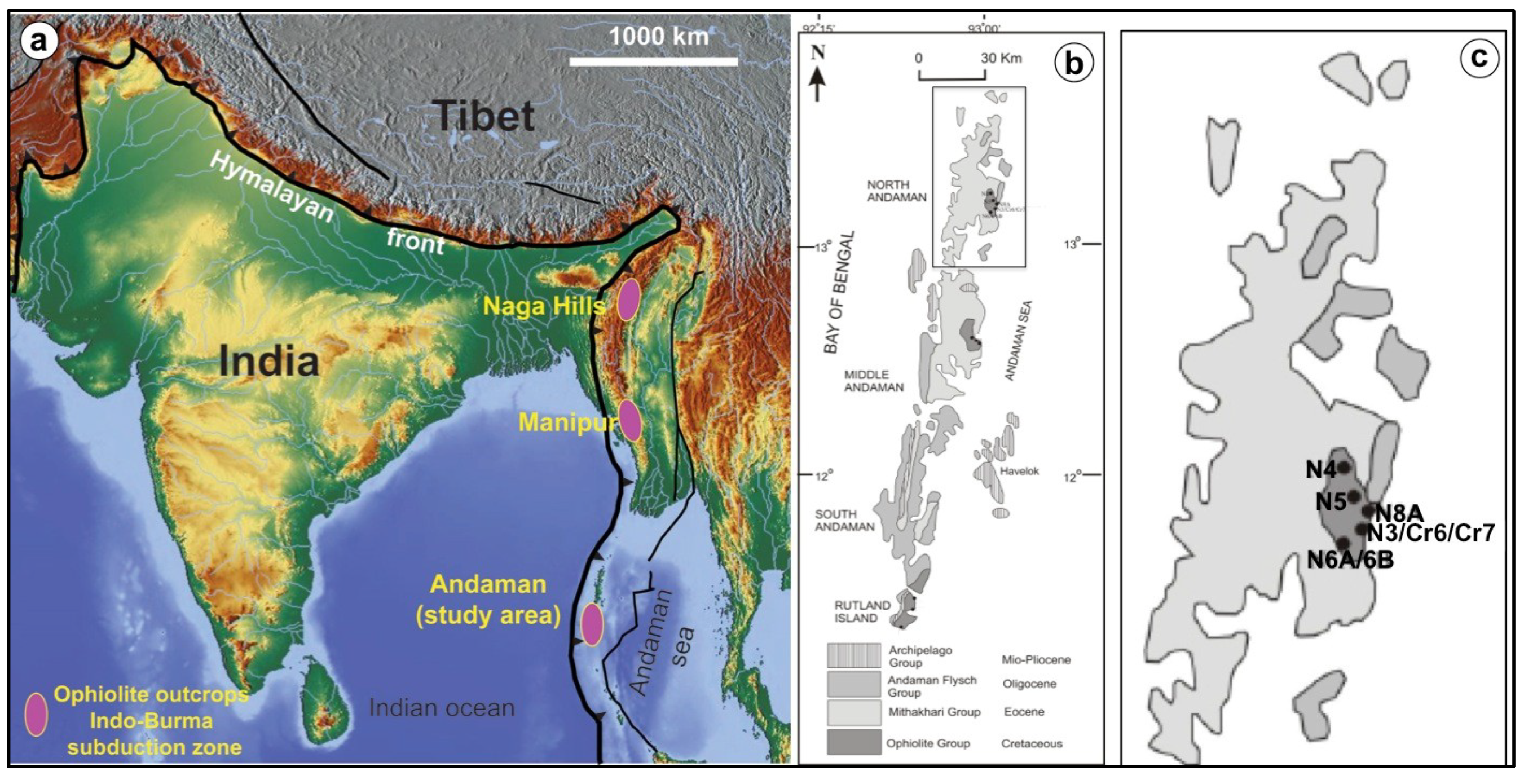
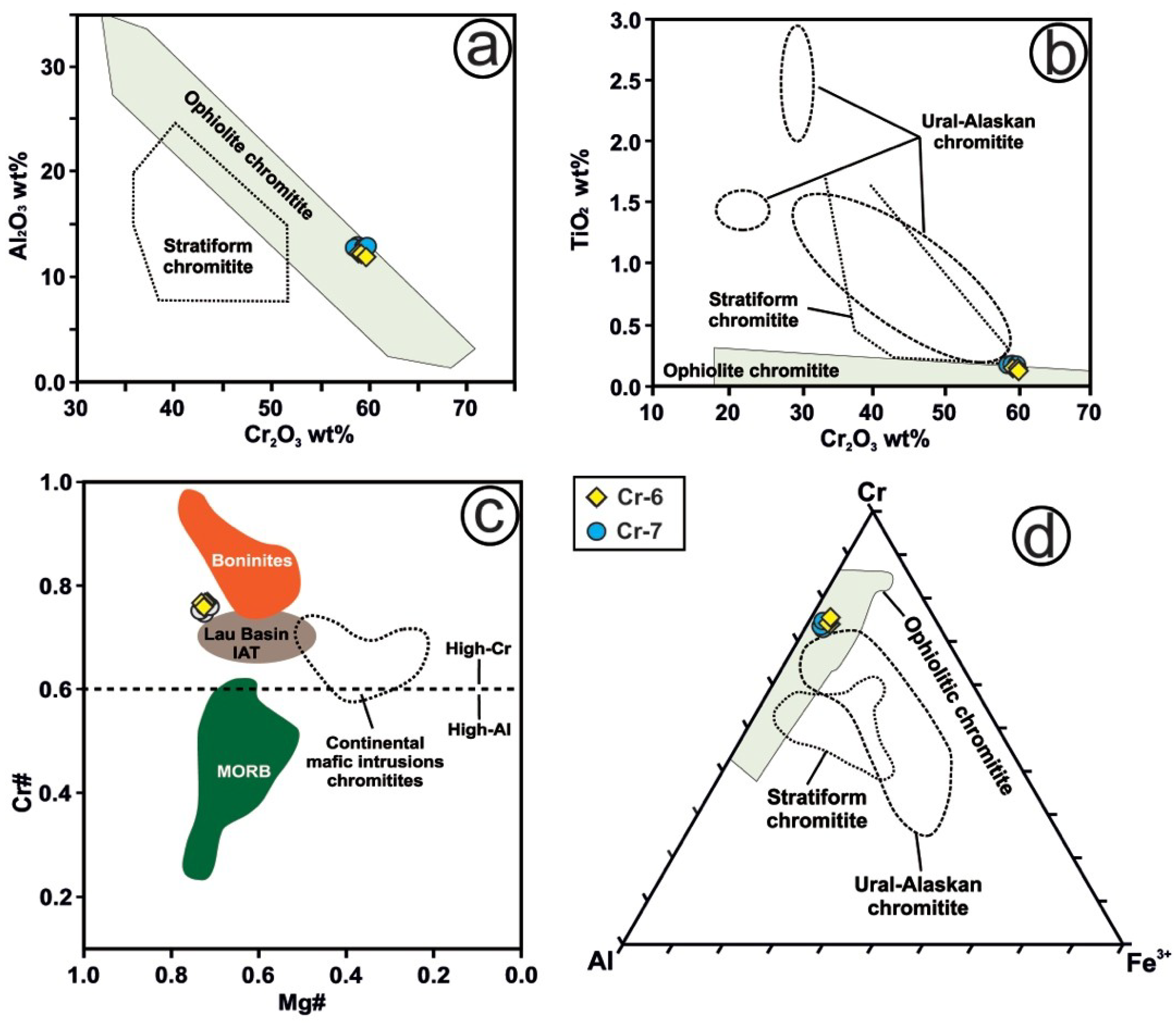
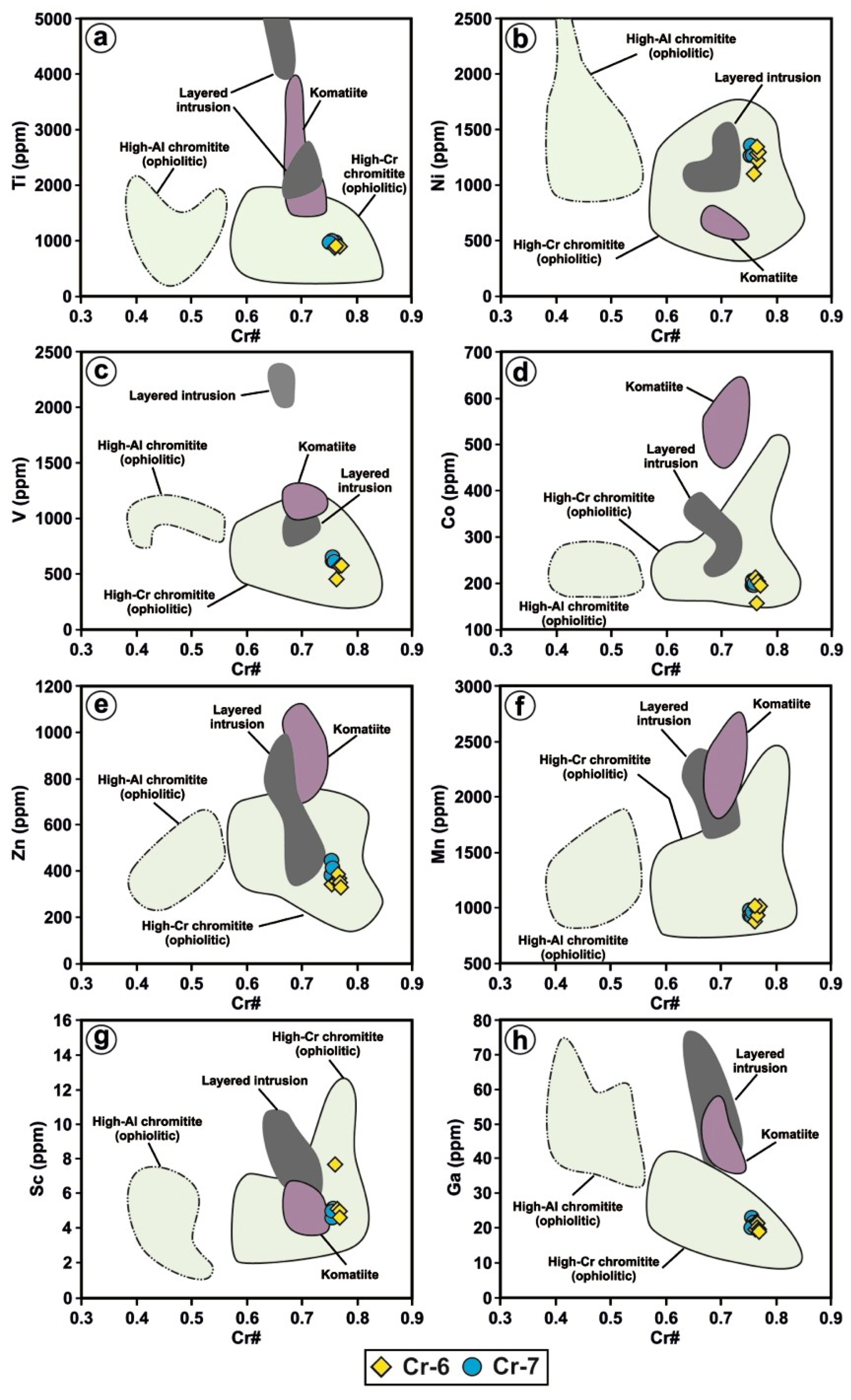
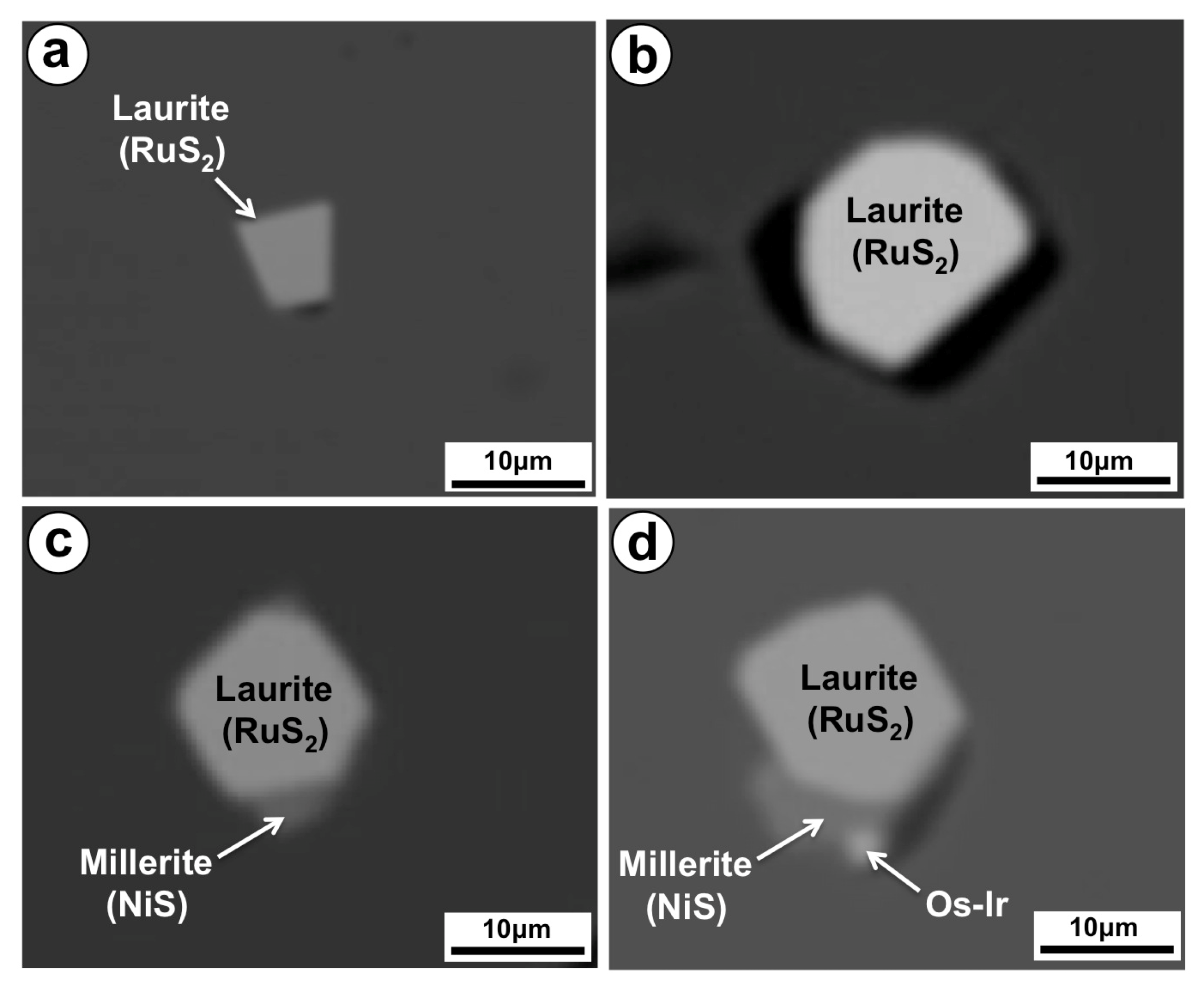
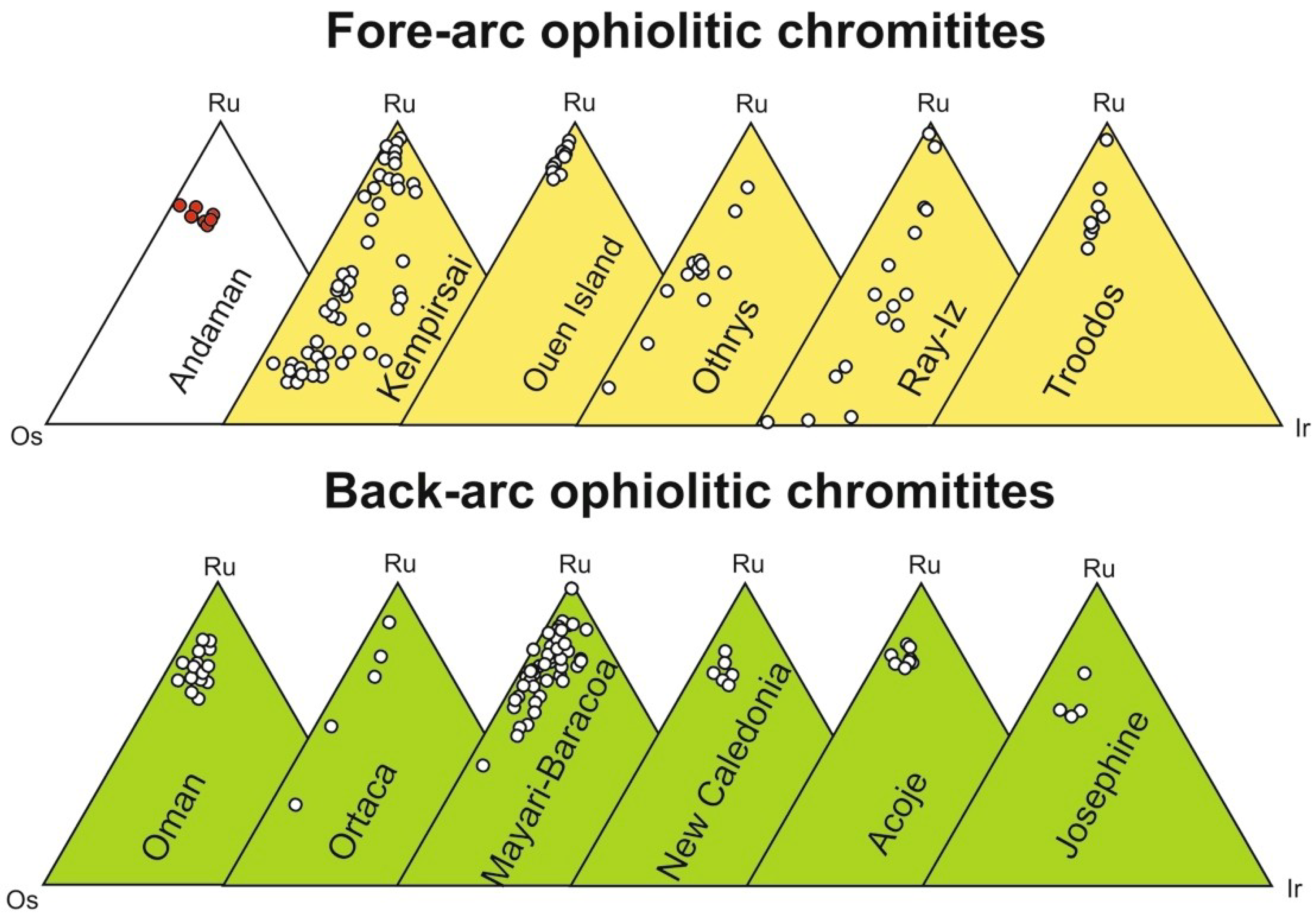

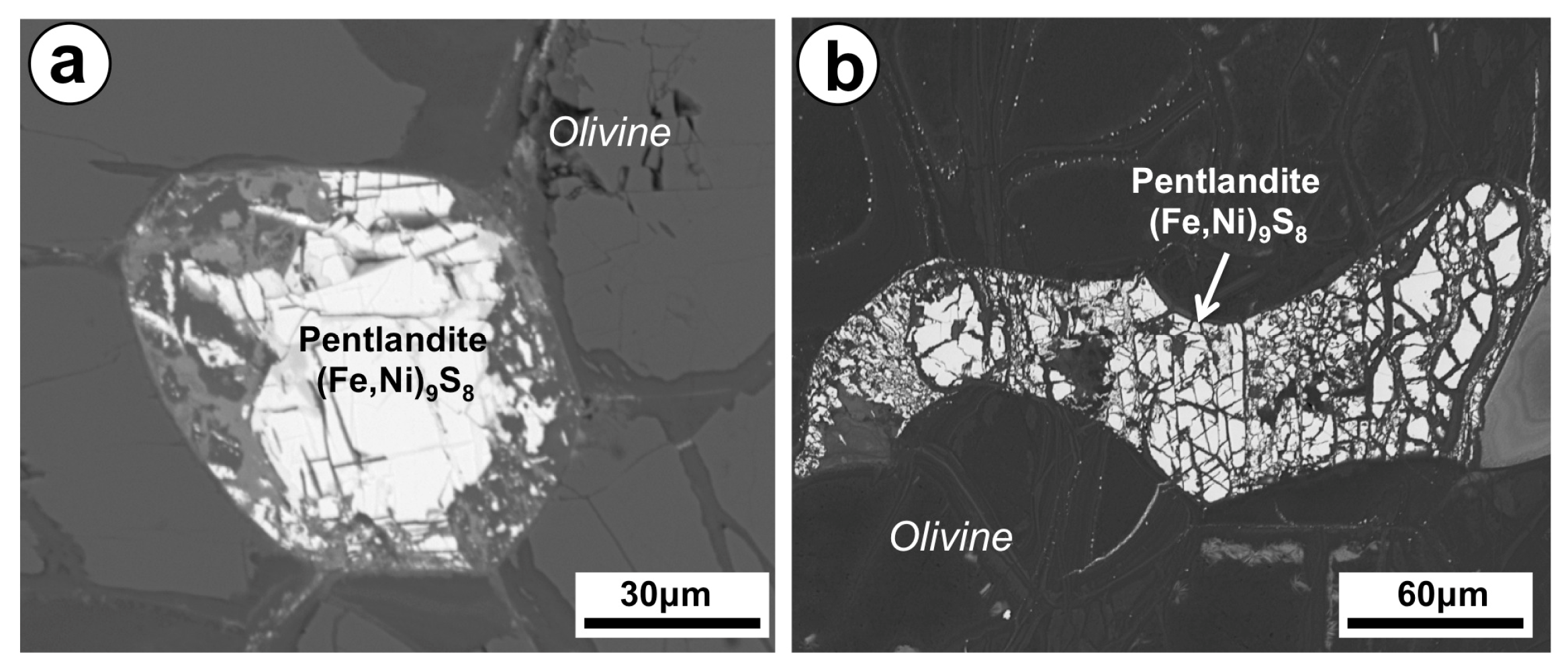
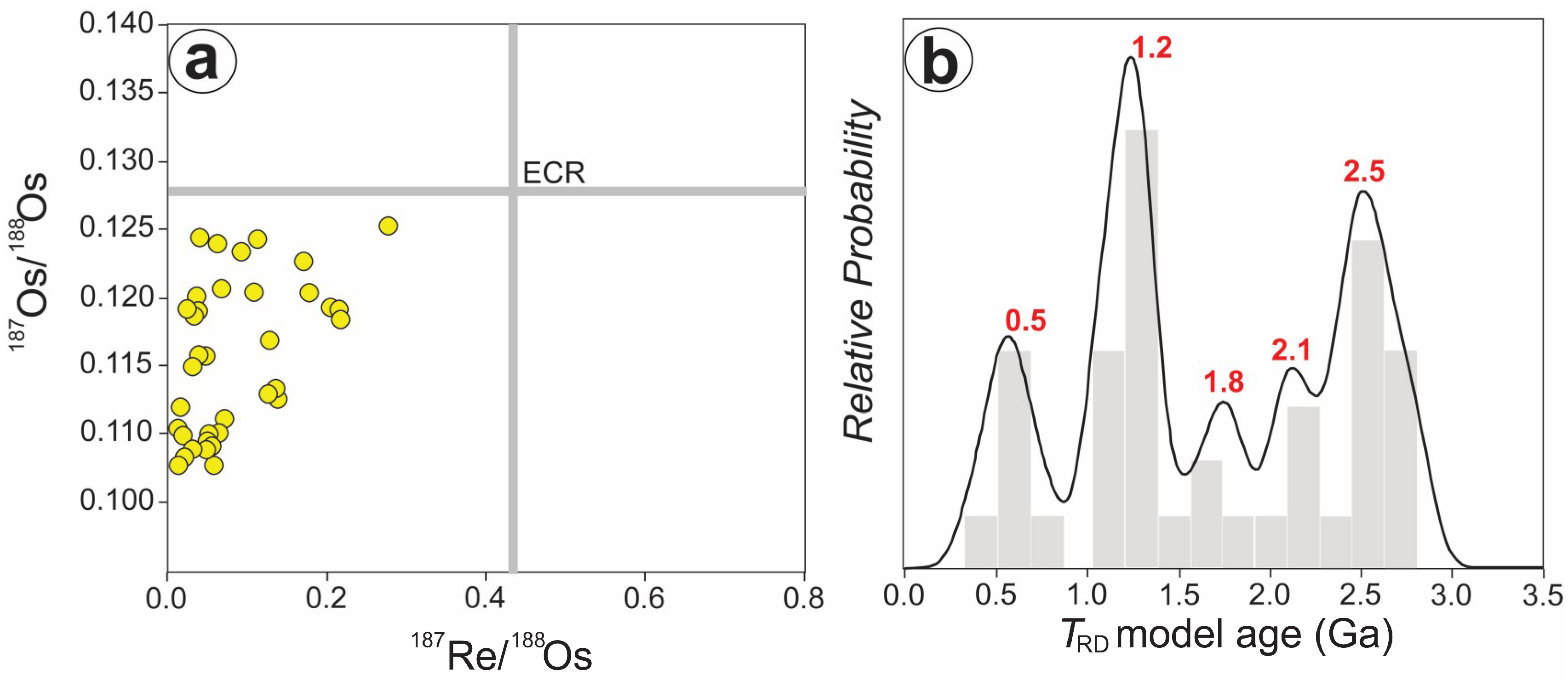
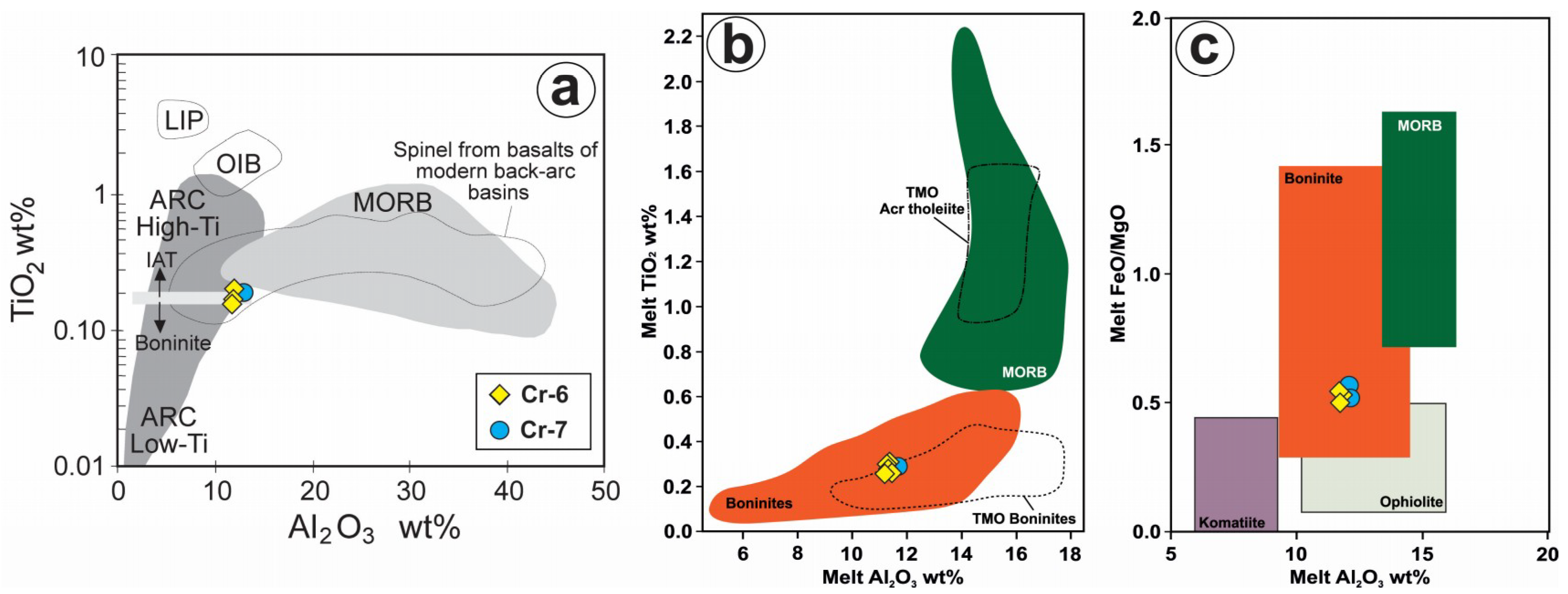


© 2020 by the authors. Licensee MDPI, Basel, Switzerland. This article is an open access article distributed under the terms and conditions of the Creative Commons Attribution (CC BY) license (http://creativecommons.org/licenses/by/4.0/).
Share and Cite
González-Jiménez, J.M.; Mondal, S.K.; Ghosh, B.; Griffin, W.L.; O’Reilly, S.Y. Re-Os Isotope Systematics of Sulfides in Chromitites and Host Lherzolites of the Andaman Ophiolite, India. Minerals 2020, 10, 686. https://doi.org/10.3390/min10080686
González-Jiménez JM, Mondal SK, Ghosh B, Griffin WL, O’Reilly SY. Re-Os Isotope Systematics of Sulfides in Chromitites and Host Lherzolites of the Andaman Ophiolite, India. Minerals. 2020; 10(8):686. https://doi.org/10.3390/min10080686
Chicago/Turabian StyleGonzález-Jiménez, José María, Sisir K. Mondal, Biswajit Ghosh, William L. Griffin, and Suzanne Y. O’Reilly. 2020. "Re-Os Isotope Systematics of Sulfides in Chromitites and Host Lherzolites of the Andaman Ophiolite, India" Minerals 10, no. 8: 686. https://doi.org/10.3390/min10080686
APA StyleGonzález-Jiménez, J. M., Mondal, S. K., Ghosh, B., Griffin, W. L., & O’Reilly, S. Y. (2020). Re-Os Isotope Systematics of Sulfides in Chromitites and Host Lherzolites of the Andaman Ophiolite, India. Minerals, 10(8), 686. https://doi.org/10.3390/min10080686





